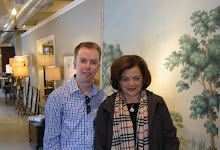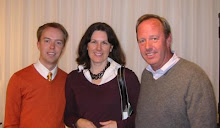
The most interesting parts of any house museum, in my opinion, are the service spaces.

Vizcaya was planned primarily around the public and entertaining rooms, which leaves only awkward leftover spaces for the numerous servants which were required in this time period. Oddly enough, the kitchen is on the 2nd floor, not in the basement (but we'll get to that later!).

The first of these service spaces is a cupboard off the dining room (marked passage on the plan above in blue). Functioning as a small butler's pantry, the space also worked as a hall between the
dining room and
tea room so had to be attractive.

The ceiling has a gorgeous painted wood ceiling with painted wood gates hiding the service cupboard which houses china storage and wash-up sink. The gilded English china seen here has an interesting story which I'll talk about at the end of this post. PS: don't you just love these painted wood cabinets?

Located on the opposite side of the Tea Room (seen on the plan above in green), the main butler's pantry is larger than most modern household kitchens. The room boasted the most modern of conveniences for the time period, including the electric annunciator panel above which showed where a servant was required when rung for.

Another modern contraption was the master clock, seen behind the cabinets above, which controlled the time on 10 clocks throughout the house (much like many schools have today).

Above you can see the painted door into the tea room. The open countertops have been converted into glassed-in display cases for the many sets of china Vizcaya posesses.

Above is the yacht china which was in Deering's yacht moored at Vizcaya. It bears the New York Yacht Club emblem as well as his own. The china is rimmed in silver to protect it from chipping on bumpy voyages.

The china seen here was ordered by Deering from England for his house in Chicago and was originally brought over, unfortunately, on the Titantic. The china obviously had to be remade and was shipped over a few years later (hand gilding isn't fast!)

By this point Vizcaya had been completed so it was brought here where it remains to this day. The originally ordered china, however, still lies at the bottom of the Atlantic. No word however on whether the White Star Line covered the replacements; does anyone know? Now THATS a story!
 The most interesting parts of any house museum, in my opinion, are the service spaces.
The most interesting parts of any house museum, in my opinion, are the service spaces. Vizcaya was planned primarily around the public and entertaining rooms, which leaves only awkward leftover spaces for the numerous servants which were required in this time period. Oddly enough, the kitchen is on the 2nd floor, not in the basement (but we'll get to that later!).
Vizcaya was planned primarily around the public and entertaining rooms, which leaves only awkward leftover spaces for the numerous servants which were required in this time period. Oddly enough, the kitchen is on the 2nd floor, not in the basement (but we'll get to that later!).  The first of these service spaces is a cupboard off the dining room (marked passage on the plan above in blue). Functioning as a small butler's pantry, the space also worked as a hall between the dining room and tea room so had to be attractive.
The first of these service spaces is a cupboard off the dining room (marked passage on the plan above in blue). Functioning as a small butler's pantry, the space also worked as a hall between the dining room and tea room so had to be attractive. The ceiling has a gorgeous painted wood ceiling with painted wood gates hiding the service cupboard which houses china storage and wash-up sink. The gilded English china seen here has an interesting story which I'll talk about at the end of this post. PS: don't you just love these painted wood cabinets?
The ceiling has a gorgeous painted wood ceiling with painted wood gates hiding the service cupboard which houses china storage and wash-up sink. The gilded English china seen here has an interesting story which I'll talk about at the end of this post. PS: don't you just love these painted wood cabinets? Located on the opposite side of the Tea Room (seen on the plan above in green), the main butler's pantry is larger than most modern household kitchens. The room boasted the most modern of conveniences for the time period, including the electric annunciator panel above which showed where a servant was required when rung for.
Located on the opposite side of the Tea Room (seen on the plan above in green), the main butler's pantry is larger than most modern household kitchens. The room boasted the most modern of conveniences for the time period, including the electric annunciator panel above which showed where a servant was required when rung for. Another modern contraption was the master clock, seen behind the cabinets above, which controlled the time on 10 clocks throughout the house (much like many schools have today).
Another modern contraption was the master clock, seen behind the cabinets above, which controlled the time on 10 clocks throughout the house (much like many schools have today). Above you can see the painted door into the tea room. The open countertops have been converted into glassed-in display cases for the many sets of china Vizcaya posesses.
Above you can see the painted door into the tea room. The open countertops have been converted into glassed-in display cases for the many sets of china Vizcaya posesses.  Above is the yacht china which was in Deering's yacht moored at Vizcaya. It bears the New York Yacht Club emblem as well as his own. The china is rimmed in silver to protect it from chipping on bumpy voyages.
Above is the yacht china which was in Deering's yacht moored at Vizcaya. It bears the New York Yacht Club emblem as well as his own. The china is rimmed in silver to protect it from chipping on bumpy voyages. The china seen here was ordered by Deering from England for his house in Chicago and was originally brought over, unfortunately, on the Titantic. The china obviously had to be remade and was shipped over a few years later (hand gilding isn't fast!)
The china seen here was ordered by Deering from England for his house in Chicago and was originally brought over, unfortunately, on the Titantic. The china obviously had to be remade and was shipped over a few years later (hand gilding isn't fast!) 



















.jpg)






















.JPG)








































































19 comments:
That china is insane. I'll take a service for 12, thanks.
You and me both, Todd!
The "modern" technology fascinates me. I'm so curious to know more about how that annunciator panel worked.
All of my boys are commenting today :-)
Eric, basically I think there was a button in each room of the house -and when the button was pressed - the white tab would flip around to a black x to show that help was needed in that room. However, I didn't see the buttons in any of the rooms. They may have been removed but often they were hidden -like below the host's seat at the dining room table, etc.
I do not know about the specifics here, but the call button might have been a hand-held device with a cord rather than on the wall. Often the wires eventually become frayed and they are the first things to go, for fear of starting a fire.
Classicist - wasn't that a bit before this time though to have a pull cord? Buttons were big in the teens I believe and this house had the latest technologies. The wonderful book by Rybczynski has very little practical behind the scenes knowledge, even on the kitchens and pantries.
Never mind -I think I misunderstood you -you mean more or a corded 'remote control?'.
That china is so incredible that it's difficult to see past it and notice how beautiful the crystalware is.
Mark -yes -the crystal was beautiful too! Unfortunately it didn't photograph well in the available lighting.
More on the call button. Yes, they had a cord and were often at a desk or favorite chair as well as at the head of the dining table (although sometimes on the floor at that location). I have also seen them as a double device so there was a call button on both sides of the master's bed.
I think you are right when you say the most interesting! It gives you an insight into a way of life that is rarely seen. The china and crystal is wonderful!
Amazing ceiling for a service area.
Call button - my grandmother had some sort of thing under her foot at the dining room table. It buzzed in the kitchen to call for the next course. As kids we loved to crawl under the table and push the bump in the carpet to see if anyone would come.
In my great grandparents' house, the old pull cords to ring the bells in the servants' hall had been retrofitted with a wire running down them and a button hidden in the tassle on the end. It preserved the look they were used to, but offered a more modern and reliable service.
"china is rimmed in silver to protect it from chipping on bumpy voyages" Could have used those on some of our own bumpy voyages.
These photos are so beautiful to me The feeling of the room is striking , The volume of the space is gracious, the cabinet work is gracious, the china and crystal are the more stunning because they are jewels set in this grace. This is an interior style widely copied today but most times misses this mark. I want to know what it is about this space, its proportion, its detail that makes my heart swoon. I want to create space like this.
Now THAT is what I call china storage space!!!
Glorious china & crystal! I would learn to dive if I thought I could retrieve that from the Titanic!!!!
I have always LOVEd the service areas of the big homes...Biltmore had some of the best. I have so enjoyed your coverage of Viscaya my dear!
I could look at historic pantries and their contents...not to mention the kitchens, all day long!
xo J~
I remember this place being in one of my Great Aunt's ancient copies of Arts and Decoration magazine (from the thirties), I was absolutely FASCINATED. I still have that tattered thing somewhere.
Post a Comment